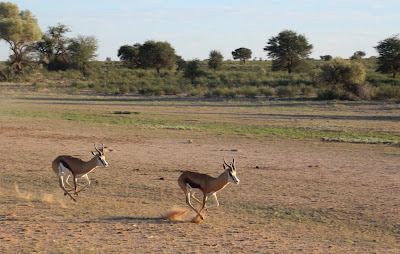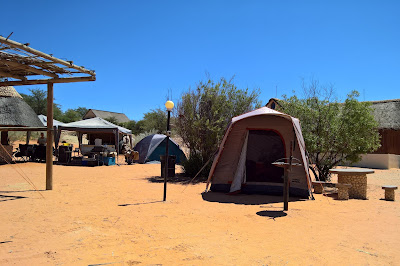When the vehicle is out of sight I find myself a spot in the garden and read. I suddenly remember that I had left my drawstring bag in Mike’s combi. I message Bobby-Jo and fortunately she manages to contact Mike, who is still in town and agrees to drop it off later. Finally it’s time to have a shower, put on some clean clothes and finish my packing. I take my luggage to the terrace where we had our final dinner together and sit down, just as Toto’s ‘Africa’ begins to play. Tears fill my eyes.
I’ve composed myself by the time Mike arrives with the
missing bag. The friendly manageress has kindly offered to drive me to the
airport and we chat on the way. I drop
my bag, buy a final can of “dry lemon” and wait for my flight. There’s a great
deal of turbulence on the way to Johannesburg, including one of those dramatic
drops where liquid remains where it was while its container plummets.
Fortunately I have only water in my cup, but the lady next to me ends up
covered in fruit juice. I’ve never been so relieved to touch down.
 Some last minute shopping at the airport, then the final leg
home. I’ve been allocated an aisle seat and as I approach I can see the woman
in the centre seat is anxious and unsettled. She tells me she gets
claustrophobic and needs a window or an aisle seat; the stewardess has found
her somebody to swap with but the seat is on the opposite side of the aircraft
to her husband, who is currently in the seat behind her. I offer to move
instead so that they can sit together and she gratefully accepts, while I’m
waiting for a suitable moment to move across she cheerfully tells me her
husband has been hunting. I bite my tongue – I’m furious that I’ve done a
kindness for somebody who thinks it’s OK to kill for pleasure.
Some last minute shopping at the airport, then the final leg
home. I’ve been allocated an aisle seat and as I approach I can see the woman
in the centre seat is anxious and unsettled. She tells me she gets
claustrophobic and needs a window or an aisle seat; the stewardess has found
her somebody to swap with but the seat is on the opposite side of the aircraft
to her husband, who is currently in the seat behind her. I offer to move
instead so that they can sit together and she gratefully accepts, while I’m
waiting for a suitable moment to move across she cheerfully tells me her
husband has been hunting. I bite my tongue – I’m furious that I’ve done a
kindness for somebody who thinks it’s OK to kill for pleasure.
Sleep eludes me, so I spend the flight trying to edit my
photos down to a manageable number and reliving a fabulous
trip. I am envious of the others, who are extending their stays, one group in South Africa and the other in Zimbabwe and Botswana. Bobby-Jo is off for a few days well-earned R&R before leading her next group. I'm sad to leave Africa, but looking forward to seeing my family again.
FOOTNOTE
I travelled with Duma Safaris, a small company specialising in wildlife photographic tours in Africa and beyond. We were led by co-owner Bobby-Jo Vial, a zookeeper and wildlife photographer, who enriches the trip with expert advice on photography and fascinating insights into animal behaviour. I learned more than on any previous wildlife trip and can heartily recommend Duma to anybody who wants to get the most out of their wildlife sightings. She's great company, too.






























 Then we’re stopped
by a passing vehicle and told that a male lion has killed an oryx. We find him
a little way past where we found the cheetahs, resting with a full belly. The
oryx has been stowed beneath a tree and a pair of jackals watch at a distance,
looking for an opportunity to scavenge. We spend some time here, enjoying the
golden morning light.
Then we’re stopped
by a passing vehicle and told that a male lion has killed an oryx. We find him
a little way past where we found the cheetahs, resting with a full belly. The
oryx has been stowed beneath a tree and a pair of jackals watch at a distance,
looking for an opportunity to scavenge. We spend some time here, enjoying the
golden morning light.


























